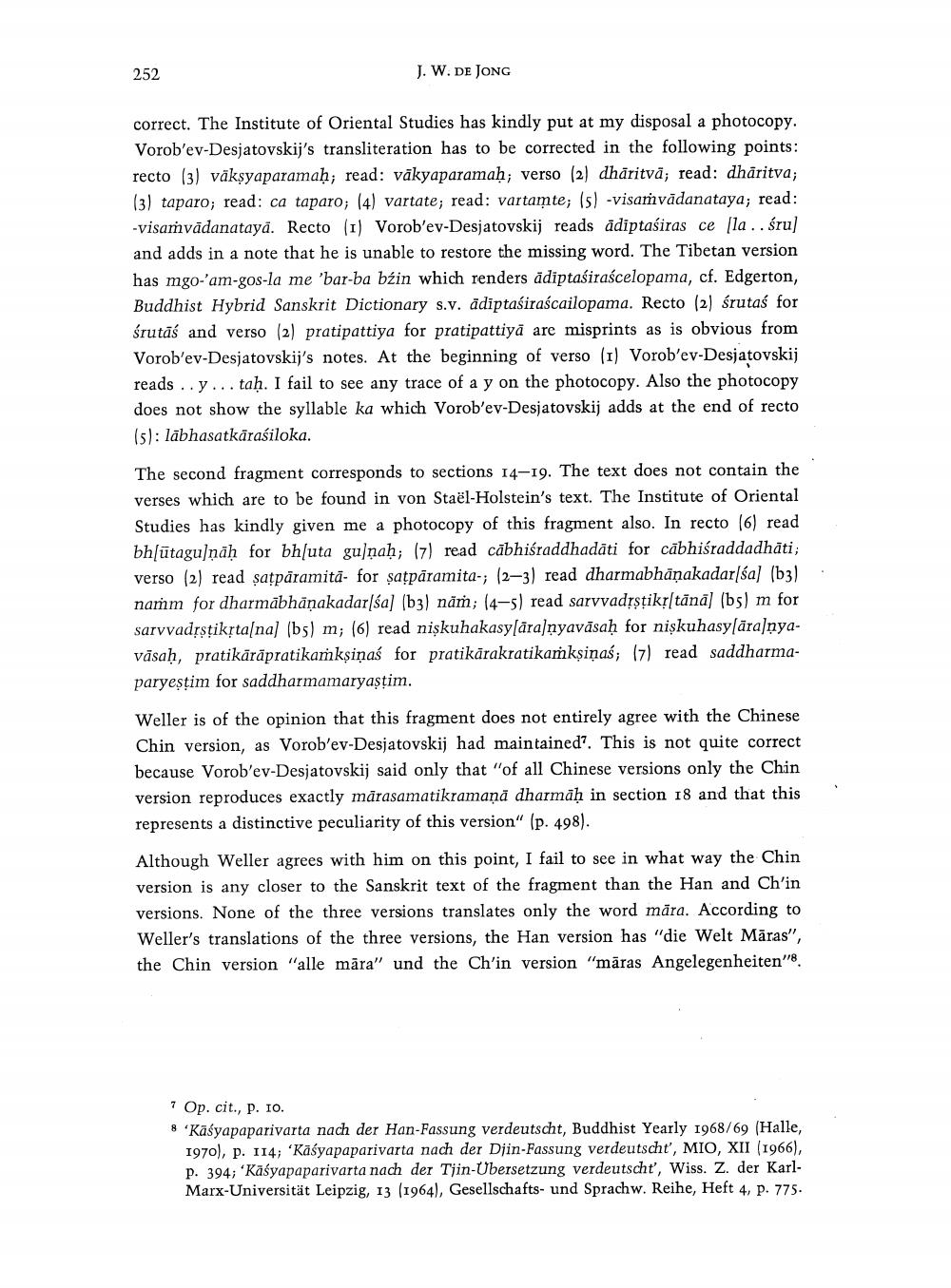________________
252
J. W. DE JONG
correct. The Institute of Oriental Studies has kindly put at my disposal a photocopy. Vorob'ev-Desjatovskij's transliteration has to be corrected in the following points: recto (3) väksyaparamaḥ, read: vakyaparamaḥ, verso (a) dhäritvä, read: dharitva, (3) taparo; read: ca taparo; (4) vartate; read: vartamte; (5) -visaṁvädanataya; read: -visamvadanatayd. Recto (1) Vorob'ev-Desjatovskij reads adiptaširas ce [la..kru) and adds in a note that he is unable to restore the missing word. The Tibetan version has mgo-am-gos-la me bar-ba bźin which renders adiptaširaścelopama, cf. Edgerton, Buddhist Hybrid Sanskrit Dictionary s.v. adiptaširaścailopama. Recto (2) árutal for śrutas and verso (2) pratipattiya for pratipattiya are misprints as is obvious from Vorob'ev-Desjatovskij's notes. At the beginning of verso (1) Vorob'ev-Desjatovskij reads.. y... taḥ. I fail to see any trace of a y on the photocopy. Also the photocopy does not show the syllable ka which Vorob'ev-Desjatovskij adds at the end of recto (5): läbhasatkäraśiloka.
The second fragment corresponds to sections 14-19. The text does not contain the verses which are to be found in von Staël-Holstein's text. The Institute of Oriental Studies has kindly given me a photocopy of this fragment also. In recto (6) read bhlutagu/nah for bhluta gujnah, (7) read cabhiśraddhadati for cabhiśraddadhāti; verso (2) read satpāramitā for satparamita-, (2-3) read dharmabhāṇakadar/śa) (b31 namm for dharmabhāṇakadarśa) (b3] năm; (4-5) read sarvvadṛstikr(tand] (bs) m for sarvvadṛstikṛtalna) (bs) m, (6) read niskuhakasy/dra/nyavasaḥ for niskuhasy[äralnyavāsaḥ, pratikārāpratikamkṣiņas for pratikarakratikaṁkṣiņas; (7) read saddharmaparyeştim for saddharmamaryastim.
Weller is of the opinion that this fragment does not entirely agree with the Chinese Chin version, as Vorob'ev-Desjatovskij had maintained. This is not quite correct because Vorob'ev-Desjatovskij said only that "of all Chinese versions only the Chin version reproduces exactly marasamatikramand dharmah in section 18 and that this represents a distinctive peculiarity of this version" (p. 498).
Although Weller agrees with him on this point, I fail to see in what way the Chin version is any closer to the Sanskrit text of the fragment than the Han and Ch'in versions. None of the three versions translates only the word mära. According to Weller's translations of the three versions, the Han version has "die Welt Maras", the Chin version "alle mara" und the Ch'in version "maras Angelegenheiten".
7 Op. cit., p. 10.
8 'Kasyapaparivarta nach der Han-Fassung verdeutscht, Buddhist Yearly 1968/69 (Halle, 1970), p. 114; 'Kasyapaparivarta nach der Djin-Fassung verdeutscht', MIO, XII (1966), p. 394; 'Kasyapaparivarta nach der Tjin-Übersetzung verdeutscht', Wiss. Z. der KarlMarx-Universität Leipzig, 13 (1964), Gesellschafts- und Sprachw. Reihe, Heft 4, p. 775.




